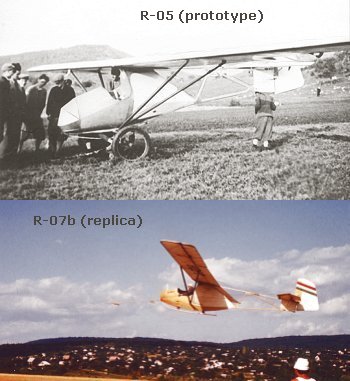HUNGARIAN GLIDERS
1933-2000
| Type designation: | Prototype: R-05, Series: R-07b |
| Name: | Vöcsök |
| Designer: | Ernő RUBIK |
| Class: | Training |
| General arrangement: | Strutted high wing, open cockpit, wire braced frame fuselage, traditional tail unit. |
| Crew: | 1 |
| First flight: | Oct. 1, 1937 |
| Manufacturer: | Aero Ever Kft, Esztergom; Transylvanian Aircraft Plant, Nagyvárad (Oradea); Experimental Aircraft Plant of the Hungarian Aeronautical Association, Dunakeszi |
| Number of built: | cca. 300 |

Short history:
The Vöcsök was derived from the EMESE-B training glider the performance of which was to good for primary training purposes. The designation of the first prototype was R-05 Vöcsök, and she first flew in 1937. The prototype was bought at the demonstration by the Glider Training School of Károly Csermely, Gödöllő. László Almásy and the Aero Club of Szentes ordered one-one Vöcsök on the spot as well. Almásy ordered the glider for the Aero Club of Egypt. This version was built with a steel pipe fuselage grid and later got the designation of R-06. She flew the first time in 1939. The serial production with some slight modifocations and new designation of R-07b started in 1938. First flight took place in 1938.
The newly established Transylvanian Aircraft Plant, Nagyvárad (Oradea) also built a series of 12 R-07b trainers in 1942-43.
The Experimental Aircraft Plant of the Hungarian Aeronautical Association, Dunakeszi, built a series of 30 gliders with modified ailerons after the war in 1955-56. This version got the designation of R-07d. Altogether about 350 Vöcsöks were built. They were in use up to the beginning of the 60s.
Structure: All wooden
Wing:
The double spar wing had a rectangular form with rounded wingtips. The wing front of the forward spar was covered by plywood, behind it by fabric. The wing had streamlined steel tube 'V' struts.
Fuselage:
The forward part of the fuselage was a partly plywood and partly fabric covered nacelle sitting on a plywood covered wooden keel. The fuselage behind the wing's trailing edge was a wire braced open frame structure.
Tail unit:
Both stabilizers' leading edges were covered by plywood. All other parts were fabric covered. The horizontal stabilizer was wire braced.
.jpg)


.jpg)
